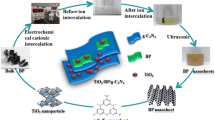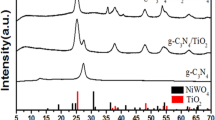Abstract
To deal with water pollution, photocatalytic degradation has become a more prominent technology in this field. In this paper, Cu2O and g-C3N4 were added to TiO2 by calcination and coupling, which greatly improved the catalytic efficiency of titanium dioxide. Using the smaller band gap of Cu2O and g-C3N4, the corresponding sunlight can be greatly increased, making up for the shortcomings of TiO2 which can only respond to ultraviolet light. Rhodamine B was used to simulate organic pollutants. RhB can be oxidized directly by photogenic holes and •OH radicals. Moreover, heterojunction can be formed between Cu2O, TiO2, and g-C3N4, which further promotes the spatial separation of photoelectron-hole pairs generated by the formation of internal electric fields. Compared with pure TiO2, the efficiency is increased by 2.5x. This study provides an effective way to improve the photocatalytic performance of TiO2 and provides a new idea for organic dye treatment and environmental remediation.










Similar content being viewed by others
Data availability
The data that supports the findings of this study are available within the article.
References
C. Loka, K.-S. Lee, Mater. Res. Bull. 137, 111192 (2021)
W. Fan, Z. Shi, X. Yang, M. Cui, X. Wang, D. Zhang, H. Liu, L. Guo, Water Res. 46, 5981–5988 (2012)
V. Eskizeybek, F. Sarı, H. Gülce, A. Gülce, A. Avcı, Appl. Catal. B 119–120, 197–206 (2012)
S. Murgolo, S. Franz, H. Arab, M. Bestetti, E. Falletta, G. Mascolo, Water Res. 164, 114920 (2019)
M. Xu, Y. Deng, S. Li, J. Zheng, J. Liu, P.-L. Tremblay, T. Zhang, Chemosphere 312, 137249 (2023)
Z.M. He, Y.M. **a, B. Tang, X.F. Jiang, Mater. Lett. 184, 148–151 (2016)
Z. Hu, M. Ge, C. Guo, Chemosphere 268, 128834 (2021)
H. Alshaikh, A. Shawky, L.S. Roselin, J. Environ. Chem. Eng. 9, 106778 (2021)
H. Park, Y. Park, W. Kim et al., J. Photochem. Photobiol. C 15, 1–20 (2013)
S.A. Rawoola, M.R. Paia, Appl. Catal. B 221, 443–458 (2018)
G. Zeng, H. You, Chem. Engin J. 412, 128498 (2021)
Z. **ong, Z. Lei, Appl. Catal. B 219, 412–424 (2017)
P. Gu, S. Zhang, R. Ma, Sep. Purif. 288, 120641 (2022)
N.P.S. Acharyulu, C. Srinivasu, Mater. Today Proc. 27, 1282–1288 (2020)
X.-N. Wei, H.-L. Wang, J. Alloys Compd. 763, 844–853 (2018)
X. Liu, M. Cui, K. Cui, Chemosphere 294, 133700 (2022)
G. Sarto, F. Lopes, F.R. dos Santos, P.S. Parreira, L.C. Almeida, Appl. Radiat. Isot. 151, 124–128 (2019)
S. Vignesh, G. Palanisamy, M. Srinivasan, N. Elavarasan, Diam. Relat. Mater. 120, 108606 (2021)
X. Chen, K. Cui, Z. Hai, Mater. Lett. 297, 129921 (2021)
G. Li, X. Nie, J. Chen, Q. Jiang, Water Res. 86, 17–24 (2015)
L. Huang, F. Peng, F.S. Ohuchi, Surf. Sci. 603, 2825–2834 (2009)
Y.-J. Liou, Y.J. Chen, B.-R. Chen, L.-M. Lee, Surf. Coat Technol. 231, 535–538 (2013)
C. Yin, Y. Liu, X. Lv, S. Lv, Appl. Surf. Sci. 601, 154249 (2022)
L. Wang, M. Yu, C. Wu, N. Deng, C. Wang, Adv. Synth. Catal. 358, 2631–2641 (2016)
Y. Zeng, Y. Xu, D. Zhong, H. Yao, N. Zhong, J. Hazard Mater. 425, 127967 (2022)
H. Gong, Y. Zhang, Y. Cao, M. Luo, Z. Feng, Appl. Catal. B 237, 309–317 (2018)
T. Ghodselahi, M.A. Vesaghi, A. Shafiekhani, A. Baghizadeh, Appl. Surf. Sci. 255, 2730–2734 (2008)
H. Shen, J. Wang, J. Jiang, B. Luo, B. Mao, Chem. Eng. J. 313, 508–517 (2017)
Z.M. He, H.P. Yang, Y.X. Huang (2023) Small , 2207370
B. Dai, Y. Li, J. Xu, C. Sun, S. Li, W. Zhao, Appl. Surf Sci. 592, 153309 (2022)
Funding
This work was supported by National Natural Science Foundation of China ( Grant Number: 11864034, 11964035 ).
Author information
Authors and Affiliations
Contributions
JX: Conceptualization, methodology, visualization, writing—review & editing, supervision; SM: resources, review and editing; TW: Investigation, methodology, formal analysis, writing manuscript.
Corresponding author
Ethics declarations
Conflict of interest
The authors state that they have no conflict of interest.
Additional information
Publisher’s note
Springer Nature remains neutral with regard to jurisdictional claims in published maps and institutional affiliations.
Rights and permissions
Springer Nature or its licensor (e.g. a society or other partner) holds exclusive rights to this article under a publishing agreement with the author(s) or other rightsholder(s); author self-archiving of the accepted manuscript version of this article is solely governed by the terms of such publishing agreement and applicable law.
About this article
Cite this article
Xu, J., Ma, S. & Wang, T. Preparation of Cu2O/ g-C3N4-modified TiO2 composite catalysts by a two-step method: degradation of RhB in sunlight. J Mater Sci: Mater Electron 34, 2249 (2023). https://doi.org/10.1007/s10854-023-11688-w
Received:
Accepted:
Published:
DOI: https://doi.org/10.1007/s10854-023-11688-w




